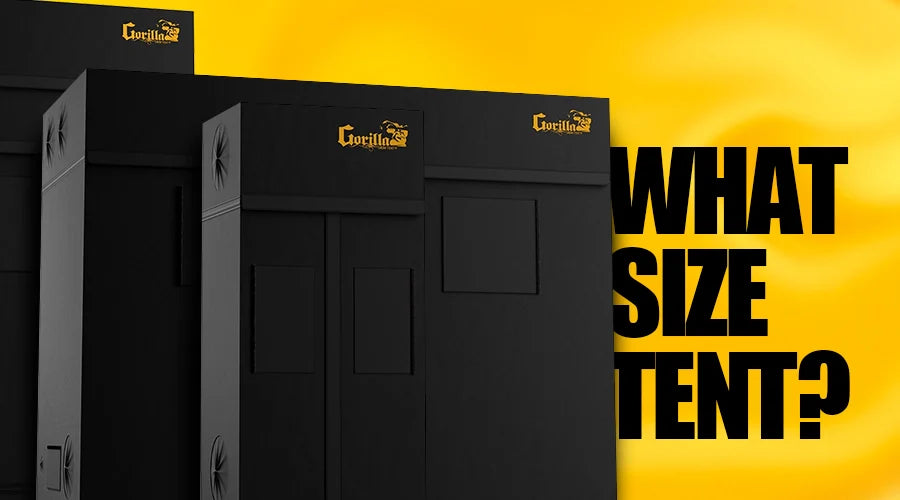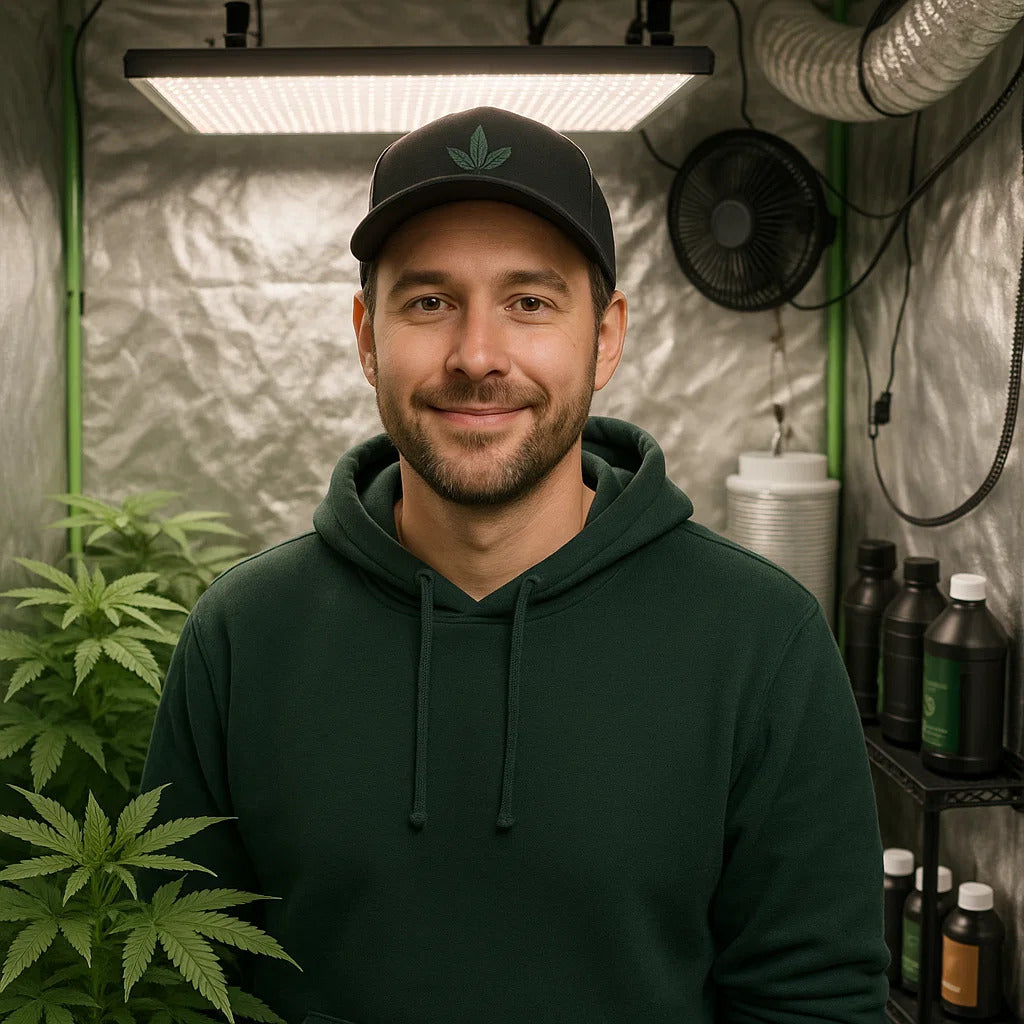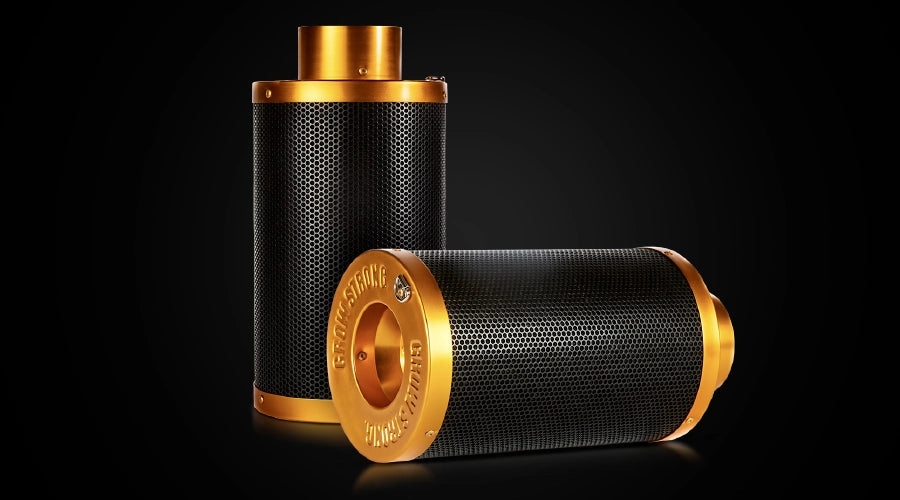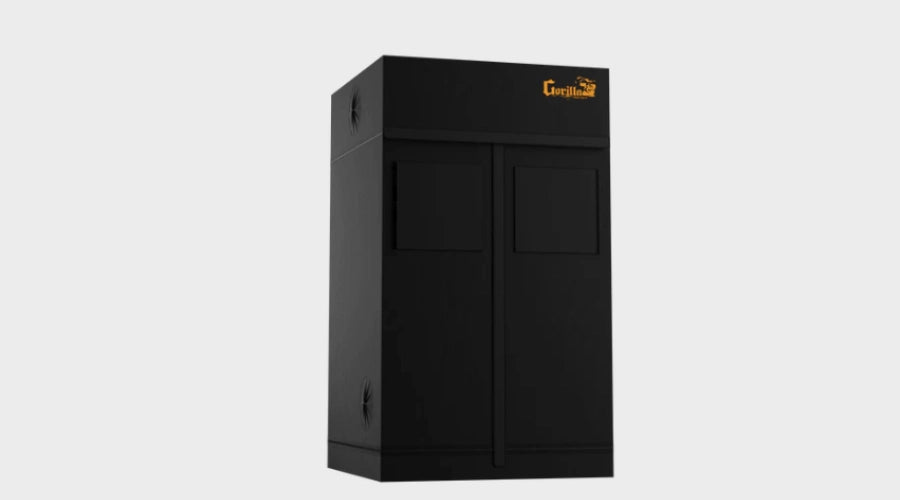
Grow Tent Size - How Do I Choose the Right Size?
Growing tents are an essential tool for indoor gardening and hydroponic systems. They provide a controlled environment for plants to thrive, allowing for optimal growth conditions. The size of a grow tent is a crucial factor in determining the success of a growing operation. In this essay, we will discuss the various sizes of grow tents and what factors to consider when choosing the right one for your needs.

What Sizes are the Grow Tents?
The most common sizes of grow tents range from 2x2 feet to 10x20 feet. The smallest tents are suitable for growing a few plants, such as herbs or flowers, while the larger tents can accommodate multiple plants or even commercial operations. When choosing the size of a grow tent, it is important to consider the amount of plants you plan to grow, the size of the grow light, and the amount of space available for the tent.
A 2x2,5 grow tent is the smallest option, and it is suitable for growing a small number of plants, such as herbs or flowers. This size of tent is also suitable for starting seedlings or cloning. With its compact size, it is ideal for small apartments or spaces with limited room.

A 3x3 grow tent is slightly larger than the 2x2 tent and can accommodate more plants or a larger grow light. This size of tent is suitable for growing a small number of plants, such as a personal marijuana crop, or for starting seedlings or cloning.
A 4x4 grow tent is a good option for growing a moderate number of plants or for larger scale operations. It can accommodate multiple plants, multiple grow lights, and a cooling system. This size of tent is suitable for a personal indoor garden or a small commercial operation.
Larger grow tents, such as 5x5, 5x9, 8x8, 9x9, 10x10 and 10x20 are suitable for larger scale operations or for growing a large number of plants. These tents can accommodate multiple plants, multiple grow lights, cooling systems, and ventilation systems. This size of tent is suitable for a commercial operation or for growing a large personal indoor garden.
The largest grow tent available is the 10x20 tent, which is suitable for commercial operations or for growing a very large number of plants. This size of tent can accommodate multiple plants, multiple grow lights, cooling systems, and ventilation systems.
How Do I Choose the Right Size?
The Type of Plants
It is important to think about the type of plants you will be growing. Different plants have different requirements, and it is important to choose a grow tent that provides the right conditions for the specific plants you will be growing. For example, some plants require high levels of light and heat, while others need more space and a cooler temperature.
The Grow Tent Light
In terms of lighting, it is important to consider the wattage of the grow light and how much space it will take up in the grow tent. A larger grow tent can accommodate a larger grow light, but it is also important to make sure that the grow light does not get too close to the plants, as this can cause damage to the leaves.
Amount of Equipment
Another factor to consider is the amount of equipment you will need in the grow tent. This includes a grow light, a cooling system, a ventilation system, a watering system, and other tools for maintaining the growing environment. A larger grow tent will allow for more space for equipment, making it easier to care for the plants.
The Height of the Grow Tent
It is also important to consider the height of the grow tent when choosing the right size. A taller tent allows for more vertical growing space, which is important for plants that grow tall. Taller grow tents also allow for more room for a cooling system or exhaust fan, which is important for controlling the temperature and humidity levels in the tent.
The Accessibility of the Plants
Another important factor to consider when choosing the size of a grow tent is the accessibility of the plants. A larger tent allows for more space to walk around the plants, making it easier to care for them. It also allows for more space for equipment, such as a watering system or a nutrient mixing station.
The Material and Construction
The material and construction of the grow tent is also important when choosing the right size. High-quality grow tents are made from heavy-duty materials, such as 600D canvas, that are tear-resistant and provide excellent insulation. The tent should also have sturdy metal frames and easy-to-use zippers for easy access.
The Climate You Live in and the Conditions
Additionally, it is important to think about the climate you live in and the conditions you want to control in your grow tent. For example, if you live in a hot and humid climate, you may need a larger grow tent with more ventilation to help control the temperature and humidity levels. If you live in a colder climate, you may want a grow tent with good insulation to keep the temperature consistent.
The Cost of the Grow Tent
Finally, it is important to consider the cost of the grow tent when choosing the right size. Larger grow tents can be more expensive, but they also provide more space for growing and equipment, making them a good investment for larger operations.
In conclusion, choosing the right size grow tent requires careful consideration of a number of factors. You need to think about the amount of plants you will be growing, the conditions you want to control, the climate you live in, the type of plants you will be growing, the wattage of the grow light, the amount of equipment you will need, and the cost. By taking the time to consider these factors, you can ensure that you choose the right size grow tent for your needs and achieve successful indoor gardening results.
How many plants fit in a 2x4 grow tent?
Small Space, Big Harvest: Growing High-Yield Crops in a 2x4 Tent
The number of plants that can fit in a 2x4 grow tent depends on a number of factors, including the size of the plants, the type of grow system being used, and the lighting and ventilation setup. In this essay, we will explore some of these factors in more detail to give you a better understanding of how many plants you can realistically expect to grow in a 2x4 grow tent.
First and foremost, it is important to understand that the size of the plants you plan to grow will have a significant impact on how many can fit in a 2x4 grow tent. For example, if you plan to grow small plants, such as herbs or lettuce, you may be able to fit several plants in the tent. On the other hand, if you plan to grow large plants, such as tomatoes you may only be able to fit one or two in the same space.
Another factor to consider is the type of grow system you plan to use. If you plan to grow in soil or a soilless medium, you will need to account for the size of the pots or containers you will be using. This will take up valuable floor space in the tent and limit the number of plants you can fit in the space. Alternatively, if you plan to use a hydroponic system, such as a deep water culture (DWC) or ebb and flow system, you may be able to fit more plants in the tent since you won't need as much floor space for pots.
The lighting and ventilation setup you use in the tent will also have an impact on how many plants you can grow. If you plan to use high-intensity lighting, such as a 600W HID or LED grow light, you may only be able to fit one or two large plants in the tent due to the space required for the light and ventilation equipment. Alternatively, if you plan to use lower-intensity lighting, such as fluorescent or LED tube lights, you may be able to fit more plants in the same space.
It is important to consider the growth cycle of the plants you plan to grow. If you plan to grow plants that have a short growth cycle, such as lettuce or herbs, you may be able to fit more plants in the same space since they won't take up as much space during the vegetative phase. On the other hand, if you plan to grow plants with a longer growth cycle, such as tomatoes, you may need to limit the number of plants you grow to ensure they have enough space to grow and mature.
Maximizing Your Grow Space: Tips for Fitting More Plants in a 2x4 Tent
Let's take a closer look at the impact of the type of grow system and lighting on the number of plants that can fit in a 2x4 grow tent.
The Type of Grow System
As mentioned earlier, the type of grow system you plan to use can have a significant impact on how many plants you can fit in a 2x4 grow tent. Different grow systems have different space requirements, which will affect the number of plants you can grow in the tent.
One of the most common grow systems used in small indoor grow spaces like a 2x4 tent is soil or soilless medium. This system involves growing plants in containers filled with a growing medium such as soil or coco coir. The size of the pots or containers you use will take up valuable floor space in the tent, which can limit the number of plants you can fit in the space. For example, if you use 5-gallon pots, you may only be able to fit 2-3 plants in the tent. If you use smaller pots, you may be able to fit more plants.
On the other hand, hydroponic systems like deep water culture (DWC) or ebb and flow systems can allow you to fit more plants in the same space since they don't require as much floor space. These systems typically use trays or reservoirs to hold the plants and nutrient solution, which can be stacked on top of each other to maximize vertical space. However, it's important to note that hydroponic systems can be more complex to set up and require more maintenance than soil-based systems.
The Lighting Setup
The type of lighting you use in your 2x4 grow tent can also affect how many plants you can grow. Different lighting setups have different space requirements, and you will need to account for this when determining how many plants you can fit in the tent.
High-intensity lighting, such as HID or LED grow lights, can produce more light and heat than lower-intensity lights, but they also require more space and ventilation. These lights typically need to be hung higher above the plants to prevent heat damage and ensure even light distribution, which can take up valuable vertical space in the tent. Additionally, high-intensity lights require powerful fans or air-cooling systems to regulate temperature and humidity, which can further limit the amount of space available for plants.
Lower-intensity lighting, such as fluorescent or LED tube lights, is more compact and produces less heat, which can allow you to fit more plants in the same space. These lights can be hung closer to the plants, which reduces the amount of vertical space needed. Additionally, they don't require as much ventilation or cooling, which can free up more space for plants.
Another factor to consider when determining how many plants can fit in a 2x4 grow tent is the size and type of the plants you plan to grow.
The Size and Type of Plants
Different plant species have different space requirements, and the size of the plants will affect how many you can fit in the tent. For example, small plants like herbs or lettuce can be grown in higher densities than larger plants like tomatoes or peppers.
In addition to the size of the plants, the growth stage of the plants will also impact how much space they require. Seedlings and young plants can be grown in smaller pots and closer together, while mature plants will need more room to spread out and develop their roots.
Building a Productive 2x4 Grow Space: Planning for Optimal Plant Count and Growth
It's also important to consider the growing conditions for the plants you plan to grow. Some plants require specific environmental conditions, such as humidity or temperature, which can affect the number of plants you can fit in the tent. If you need to maintain a specific temperature or humidity range, you may need to leave more space between the plants to ensure adequate airflow and prevent mold or mildew.
In conclusion, the number of plants you can fit in a 2x4 grow tent will depend on several factors, including the size of the plants, the type of grow system, and the lighting and ventilation setup. While it's possible to fit several small plants in a 2x4 tent, you may need to limit the number of larger plants to ensure they have enough space to grow and mature. It's essential to carefully consider all of these factors when planning your grow space to ensure you get the best possible results from your plants.
Maximizing Yield with a 4x4 Grow Tent Setup: Tips and Strategies
A 4x4 grow tent offers a versatile and manageable space for indoor gardening, providing ample room to cultivate a bountiful harvest. Whether you're a beginner or an experienced grower, maximizing yield is a common goal. In this article, we share valuable tips and strategies to help you make the most of your 4x4 grow tent setup and achieve impressive yields.
Harvesting Success: Strategies for Maximizing Yield in Your 4x4 Grow Tent
Choosing the Right Equipment:
Selecting the appropriate equipment sets the foundation for a successful grow tent setup. We discuss essential items such as grow lights, ventilation systems, fans, and carbon filters. Understanding the specific requirements of your plants and matching them with suitable equipment ensures optimal growth conditions and maximizes yield potential.
Optimal Layout and Plant Spacing:
Efficient use of space is crucial in a 4x4 grow tent. We explore different layout strategies and plant spacing techniques to maximize light exposure and airflow. From utilizing trellises and training techniques to implementing a strategic rotation schedule, we offer insights on how to make the most of the available space and increase overall yield.
Selecting High-Yielding Plant Varieties:
Choosing plant varieties that are known for high yields is a smart strategy to maximize your harvest. We discuss popular options for the 4x4 grow tent setup, considering factors such as growth characteristics, flowering times, and overall productivity. By selecting the right plant varieties, you can optimize your space and efforts for maximum yield potential.
Lighting Considerations:
Proper lighting is paramount for plant growth and yield. We delve into the importance of choosing the right grow lights and setting up an optimal lighting schedule for your 4x4 grow tent. Exploring different types of lights, such as LED or HPS, and understanding their benefits and considerations will help you provide the ideal light spectrum and intensity for your plants' needs.
Temperature and Humidity Control:
Maintaining appropriate temperature and humidity levels is crucial for plant health and productivity. We provide guidance on monitoring and controlling these factors within your 4x4 grow tent. From utilizing exhaust fans and air circulation to employing humidifiers or dehumidifiers, we offer tips for achieving the ideal climate conditions that promote vigorous growth and maximize yield.
Nutrient Management and Feeding Schedule:
Proper nutrient management is vital for maximizing yield. We discuss the importance of pH balance, nutrient ratios, and feeding schedules. By understanding the nutritional needs of your plants and implementing a well-rounded feeding regimen, you can ensure they receive the essential elements required for robust growth, flowering, and, ultimately, a higher yield.
Training and Pruning Techniques:
Implementing training and pruning techniques can help optimize space utilization and enhance yield. We explore methods such as topping, low-stress training (LST), and defoliation. These techniques promote even canopy development, improve light penetration, and encourage more bud sites, resulting in increased yield potential within your 4x4 grow tent.
Pest and Disease Prevention:
Protecting your plants from pests and diseases is crucial for maintaining healthy and productive growth. We discuss proactive measures such as proper sanitation practices, integrated pest management (IPM), and regular plant inspections. By preventing and addressing pest and disease issues promptly, you can safeguard your plants and ensure maximum yield potential.
Harvesting and Post-Harvest Tips:
Knowing the optimal time to harvest and implementing proper post-harvest techniques are essential for preserving the quality and potency of your yield. We provide insights on determining harvest readiness, drying and curing techniques, and storage considerations. These practices ensure that your hard-earned harvest maintains its freshness and potency for an enjoyable end product.
Achieving maximum yield in a 4x4 grow tent requires careful planning, attention to detail, and implementing effective strategies. By selecting the right equipment, optimizing space utilization, choosing high-yielding plant varieties, providing optimal lighting and climate conditions, managing nutrients, employing training techniques, and preventing pest and disease issues, you can set the stage for a successful harvest.
Remember to stay vigilant throughout the entire growth cycle, monitoring your plant's progress and making necessary adjustments along the way. Keep a close eye on environmental factors, maintain a consistent feeding schedule, and address any potential issues promptly. With dedication and a bit of experimentation, you can fine-tune your 4x4 grow tent setup to maximize yield and reap the rewards of a thriving indoor garden.
So, roll up your sleeves, embrace the joy of gardening, and let your 4x4 grow tent become a productive oasis. With the right knowledge and a passion for cultivating healthy plants, you'll be well on your way to maximizing your yield and enjoying the fruits of your labor. Happy growing!

Lena Myles
I'm a mushroom enthusiast and home cook based in Oregon. I'm passionate about foraging and creating fungi-focused recipes, especially delicious, plant-based dishes using gourmet mushrooms like trumpet, shiitake, and oyster. When I’m not in the kitchen, you’ll usually find me wandering the woods in search of new wild flavors.


